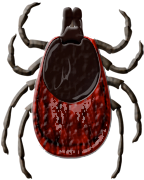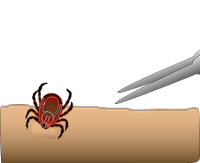Ticks

What are Ticks?
Ticks are in the arachnid family which makes them related to spiders. As ectoparasites, they attach to animals, pets, and people using complex mouthparts resembling a "harpoon". While they are attached, they suck blood for several days, dropping off once engorged.
How big are they?
Larvae and nymphs are about the size of a "." while adult ticks vary between a small "o" and a large "O".

The Facts:
Ticks are blooding feeding parasites that belong in the arachnid class.
They attach to birds, reptiles, and mammals using complex piercing mouthparts.
While attached to the host, ticks can suck blood for several days. They drop off their host once they have completed their blood meal.
Ticks live on or near the ground waiting for a host to pass by them. They have sensory organs in their front legs at detect heat, movement, and carbon dioxide from warm-blooded animals. This stimulates their host-seeking behavior know as “questing”. Questing ticks often climb onto tall grass or plants hoping to snag onto animals
The Myths:
Ticks do not jump or fly. Ticks crawl onto passing host using their extended front legs.
Contrary to popular belief, embedded ticks should NOT be burned off.
Where are they found?
Ticks live on or near the ground waiting for a host. they often climb onto tall grass or plants hoping to snag onto passing animals or humans.
How do they find a host?
Tick have sensory organs in their legs that detect carbon dioxide, odors, and heat given off by warm blooded animals. When an animal is detected, ticks crawl to the tips of vegetation and use their barbed front legs to snag onto the animal. This behavior is called “questing”. Ticks cannot jump or fly.
Ticks and Disease
While many species of ticks exist, only a few are known to spread disease. The species of concern in our area is Ixodes pacificus or "Black-legged Tick".
Lyme Disease:
This is an infection caused by bacteria transmitted by the bite of certain ticks. The disease often starts as a circular skin rash around the area of the bite and can progress to more serious stages affecting joints, nerve, or heart tissue. Lyme disease has been reported in 47 states including California (mainly northern coastal area).
Ehrlichiosis:
Less common than Lyme disease, it is also spread by tick bites. One to three weeks after the bite, fever, headache, and muscle aches develop. Fatigue and nausea may also occur. Both Lyme disease and Ehrlichiosis are treatable with antbiotics.
Other Diseases:
Rocky Mountain spotted fever, typhus, relapsing fever, tularemia, tick paralysis. These diseases are uncommon in California.
Preventing Tick Bites:
Ticks are most commonly encountered by people when engaged in outdoor activities such as hiking, camping, hunting, ect.
Follow these recommendations to reduce your chances of bites when outdoors:
•Wear light colored clothing to spot crawling ticks.
•Apply insect repellant containing DEET following directions on the label.
•Check regularly for ticks when outdoors.
•Examine skin and scalp upon returning. Also inspect pets.

Tick Removal:
If a tick becomes attached, the best method for removal is to grasp the tick with fine tipped tweezers. Pull the tick away from the skin using a slow and steady motion. Do not grab the body as this may "squeeze" fluids from the tick into the opening. Use of substances such as petroleum jelly, finger nail polish, and matches are ineffective.
When to Call a Doctor:
- If unable to remove entire tick.
- If red "bull's-eye" rash appears.
- If fatigue or flu like symptoms occur.
